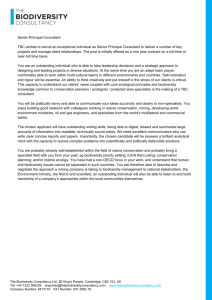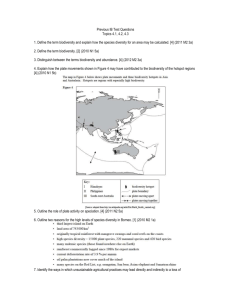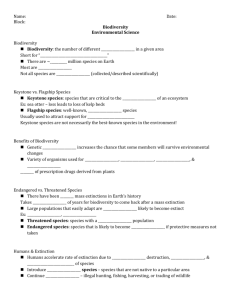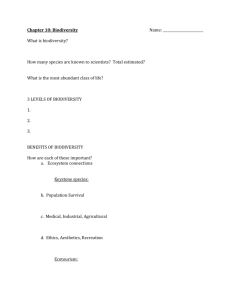- Nature Conservation Council of NSW
advertisement
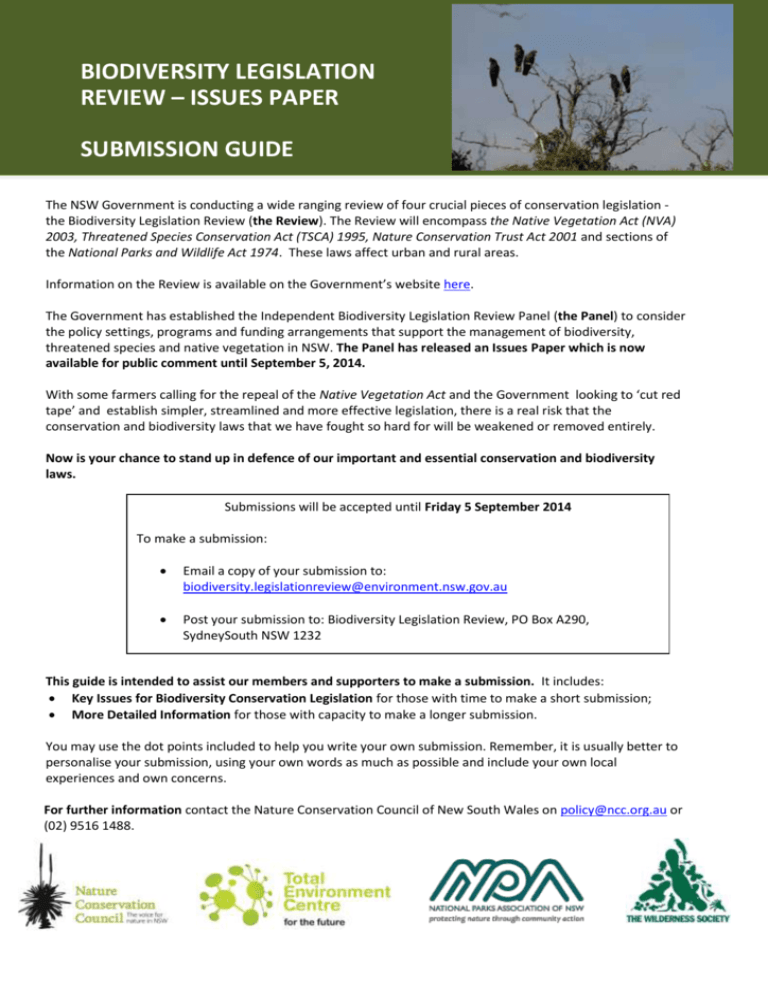
BIODIVERSITY LEGISLATION REVIEW – ISSUES PAPER SUBMISSION GUIDE The NSW Government is conducting a wide ranging review of four crucial pieces of conservation legislation the Biodiversity Legislation Review (the Review). The Review will encompass the Native Vegetation Act (NVA) 2003, Threatened Species Conservation Act (TSCA) 1995, Nature Conservation Trust Act 2001 and sections of the National Parks and Wildlife Act 1974. These laws affect urban and rural areas. Information on the Review is available on the Government’s website here. The Government has established the Independent Biodiversity Legislation Review Panel (the Panel) to consider the policy settings, programs and funding arrangements that support the management of biodiversity, threatened species and native vegetation in NSW. The Panel has released an Issues Paper which is now available for public comment until September 5, 2014. With some farmers calling for the repeal of the Native Vegetation Act and the Government looking to ‘cut red tape’ and establish simpler, streamlined and more effective legislation, there is a real risk that the conservation and biodiversity laws that we have fought so hard for will be weakened or removed entirely. Now is your chance to stand up in defence of our important and essential conservation and biodiversity laws. Submissions will be accepted until Friday 5 September 2014 To make a submission: Email a copy of your submission to: biodiversity.legislationreview@environment.nsw.gov.au Post your submission to: Biodiversity Legislation Review, PO Box A290, SydneySouth NSW 1232 This guide is intended to assist our members and supporters to make a submission. It includes: Key Issues for Biodiversity Conservation Legislation for those with time to make a short submission; More Detailed Information for those with capacity to make a longer submission. You may use the dot points included to help you write your own submission. Remember, it is usually better to personalise your submission, using your own words as much as possible and include your own local experiences and own concerns. For further information contact the Nature Conservation Council of New South Wales on policy@ncc.org.au or (02) 9516 1488. KEY ISSUES FOR YOUR SUBMISSION ON BIODIVERSITY CONSERVATION Existing biodiversity and conservation legislation, including the provisions of the Native Vegetation Act 2003 and Threatened Species Conservation Act 1995, must be maintained and strengthened. In view of the major biodiversity losses since European settlement and ongoing removal and economic impacts, there must be an overarching object to protect and conserve biodiversity. The principles of ecologically sustainable development, that underpin existing legislation, must be maintained. The must be a clear legislative commitment to maintain or improve environmental outcomes as the key test of clearing proposals. There must be a clear legislative commitment to end broad-scale land clearing across NSW. The NSW government should commit to ‘no net loss’ of native vegetation reflecting its diversity and value. The application of important land clearing laws should be extended so that all development (including extractive industry, forestry, urban development and agriculture) subscribes to the same policy of “improving or maintaining” environmental outcomes. Decisions must be based on objective science-based decision making criteria (e.g. Environment Outcomes Assessment Methodology under the NV Act), and discretionary decision making should be very limited. Where development is approved that significantly impacts native flora or fauna, the ‘like for like’ offsetting principle is fundamental and must not be weakened. The role of the Independent Scientific Committee under the TSC Act should be retained and listing must continue to be based on the professional advice of the Scientific Committee. Routine Agricultural Management Activities (RAMAs) should be restricted to genuinely low impact activities. Cumulative impact must be a key consideration in assessing clearing and development proposals. More than enough land has been cleared to produce food and fibre and on which to improve the productivity of farming. The government should ensure the legislation is enforced and use extensive education resources to communicate its importance and provisions. 2 MORE DETAILED INFORMATION THE CASE FOR BIODIVERSITY AND CONSERVATION LAWS Over the past two centuries, the natural diversity of New South Wales has been severely diminished by human activities, including land clearing, development, over-exploitation of natural resources and introduction of invasive species. The 2012 NSW State of the Environment Report confirms that: The overall diversity and richness of native species in New South Wales remain under threat of further decline. Thirty-five additional species have been listed as threatened under NSW legislation since 2009, including 11 terrestrial vertebrate species… Currently, 989 species of plants and animals, 49 populations and 107 ecological communities are listed as threatened in NSW legislation, and 45 key threatening processes have been identified. These numbers continue to rise. The NSW Government has recognised its responsibility to protect the natural environment in its current State Plan, NSW 2021, in which it commits “to protect high value conservation land, native vegetation and biodiversity” (Goal 22). The Native Vegetation Act 2003 has played a critical role in reducing the loss of native vegetation in NSW. The Threatened Species Conservation Act 1995 has been crucial in identifying and addressing threats to biodiversity (including land clearing). Removing or weakening the protections provided by these Acts will accelerate biodiversity loss in NSW. If the Government is serious about protecting high value conservation land, native vegetation and biodiversity, then it must maintain and strengthen our existing laws. PROTECTING NATIVE VEGETATION The Native Vegetation Act 2003 has played a critical role in reducing the loss of native vegetation in NSW. Native vegetation: - Protects valuable topsoil from erosion, water logging and salinity; Provides shelter for stock and crops from wind and weather; Provides pollination and pest control; Moderates the climate – and positively influences rainfall patterns; Protects threatened species of animals and plants from extinction; and Provides health, recreation and amenity benefits to human beings. Destruction of native vegetation extinguishes or reduces all these benefits, and also has direct detrimental impacts including loss of freshwater quality, loss of topsoil and death of native animals and plants. By protecting native vegetation, land clearing laws have also made an important contribution to greenhouse gas abatement efforts. 3 In many cases the impacts of clearing are felt far beyond the property in question. Significant amounts of public money are presently being spent remedying the damage past clearing has caused. A recent WWF report shows that approved clearing has fallen, on average, from about 80,000 hectares to only 911 hectares a year (though exempt, grandfathered and possibly illegal clearing remains a good deal higher than this) and that clearing approved after 2005 has been offset by protection and recovery of an average of 7,852 hectares annually. [NSW native vegetation act saves Australian wildlife, Martin FJ Taylor – WWF Australia and Professor Christopher Dickman – University of Sydney (2014)] The recent expansion of RAMAs to include clearing of invasive native species (INS), thinning of native vegetation, and clearing of paddock trees is likely to lead to an extensive increase in the amount of clearing that is exempt from assessment under the Native Vegetation Act 2003. The effect will be to open the door to broad-scale land clearing and lead to significant loss of native habitat. It will place further stress on fragile soils, rivers and catchments. There are a number of key areas in which the Native Vegetation Act could be strengthened: - Regrowth vegetation should be assessed for its conservation significance and habitat value for threatened species. Significant regrowth vegetation should be mapped and protected. Provisions should be strengthened to reduce loopholes allowing clearing without a Property Vegetation Plan. The application of important land clearing laws should be extended so that all development (including extractive industry, forestry, urban development and agriculture) subscribes to the same policy of “improving or maintaining” environmental outcomes. THREATENED SPECIES CONSERVATION The Threatened Species Conservation Act 1995 has played an important role in identifying, increasing scrutiny of and seeking to ameliorate the threats that target biodiversity and important habitat. In 2012, the Australian Network for Environmental Defenders’ Offices undertook an assessment of the adequacy of threatened species and planning laws in all jurisdictions of Australia (www.edonsw.org.au/planning_development_heritage_policy), and found that there a number of weaknesses with the way threatened species and endangered ecological communities are managed in NSW: - A key failing of the assessment of threatened species under the EP&A Act is that even where an EIS or SIS demonstrates that a development will have potentially devastating impacts on threatened species or their habitats, this does not operate as a stop on development under the EP&A Act. - There is no requirement for consent authorities to refuse consent to development proposals where an environmental assessment has shown that there will be an unacceptable impact on threatened species, endangered ecological communities or their habitats. - The listing of threatened species under the TSC Act does not activate a requirement to consider such listings (particularly of Endangered Ecological Communities) when making or reviewing Local Environmental Plans (LEPs) in LEPs. 4 Offsetting still results in a net loss of threatened species habitat likely resulting in a loss of threatened species and endangered ecological communities. Recent amendments to regulations under the Rural Fires Act (the so-called 10/50 Regulations) enable habitat removal whether or not the habitat is important to threatened species. There are a number of key areas where the protection of threatened species could be strengthened: - The legislation should require development of recovery plans and critical habitat designation for all species, populations and ecological communities listed under the Threatened Species Conservation Act 1995 within 4 years. Suitable funding for the development and implementation of these plans must be provided. Databases can be improved so that cumulative impact can be adequately assessed. The Listing process must continue to be based on the professional advice of the Scientific Committee. BIODIVERSITY CONSERVATION, AND PLANNING AND DEVELOPMENT There must be improved integration between the Environmental Planning and Assessment Act1979 (EPA Act) and biodiversity and conservation legislation in NSW. In particular, the EPA Act must not be allowed to ‘switch off’ biodiversity and conservation laws. Development should seek to minimise negative impacts on native vegetation and fauna consistent with goal 22 of the NSW 2021 - Protect our natural environment. There are significant concerns with the EPA Act’s ‘7 part test’ which requires an assessment of whether a development will have a significant impact on threatened species or ecological endangered communities; the test is often not undertaken where required, and is applied inconsistently. Local councils should be required to prepare an LEP that has the overall effect of adequately protecting biodiversity There must be strengthened protection for native vegetation and threatened species habitat under the Environmental Planning & Assessment Act 1979 to ensure no net loss of native vegetation from urban, industrial and mining development. Assessment of cumulative impact must be a key element of the planning process If bilateral assessment and approval agreements are to be established under the Commonwealth Environment Protection and Biodiversity Conservation Act 1999 then NSW (and other States) biodiversity protection laws must meet Australia’s obligations under the various international treaties to which Australia is a signatory, including the Convention on Biological Diversity, the Convention on International Trade in Endangered Species of Wild Flora and Fauna, and the Convention Concerning the Protection of the World Cultural and Natural Heritage. 5 OFFSETTING The Government must commit to clear biodiversity offsetting principles and develop a consistent framework applied transparently for biodiversity offsetting across all areas of Government. The Draft NSW Biodiversity Offsets Policy for Major Projects, recently exhibited for public comment, represents a significant and unacceptable departure from established offsetting principles, including principles previously adopted by the NSW Government. The ‘like for like’ offsetting principle is fundamental and must not be weakened. Both the principles of additionality, and a commitment to the hierarchy of actions in which offsetting is used only as a last resort after both avoidance and mitigation, should be maintained. Offsets must be fully protected in perpetuity. INVASIVE SPECIES Invasive plants and animals represent the second greatest threat to biodiversity in NSW after habitat loss (Coutts-Smith & Downey, 2006; EPA, 2012). Funding for assessing and combating the threat of invasive plants and animals should be increased. More resources are required to assess the threats posed by invasive species. Assessment of threats allows prioritisation of resources and control activities toward those species posing the greatest threats. The Biodiversity Legislation Review should also consider the recently proposed framework biosecurity legislation for NSW which recommends legislative tools and powers required to manage pests, diseases, weeds and contaminants in NSW. The framework will be used to form the basis of the NSW Biosecurity Act, which will support the national agreed principle that biosecurity is a shared responsibility. PROTECTED AREAS The conservation of nature must remain as the primary focus of protected areas. Commercial and recreational activities that compromise conservation values should be excluded from protected areas. The number and scale of protected areas in NSW should be expanded. Planning for protected areas should include accommodation of range shifts and the need for climate refugia resulting from climate change. 6 ADDITIONAL INFORMATION Recent reports highlight the importance of NSW biodiversity and conservation legislation: NSW native vegetation act saves Australian wildlife, Martin FJ Taylor – WWF Australia and Professor Christopher Dickman – University of Sydney (2014) Laws for the bush - Benefiting biodiversity and people, Leigh J Martin, Total Environment Centre, July 2014 EDO NSW has undertaken a great deal of work to defend the environment and advance the laws that protect biodiversity. A number of EDO’s discussion papers and law reform submissions are available to download from the EDO website: www.edonsw.org.au/biodiversity_legislation_review 7





